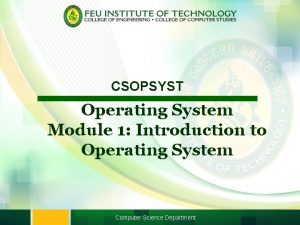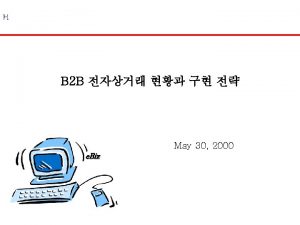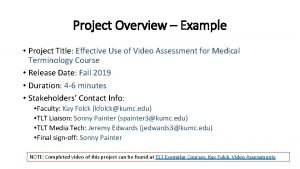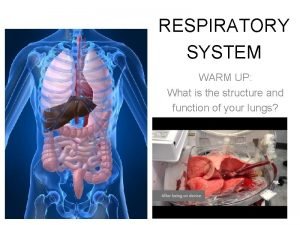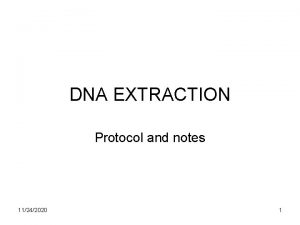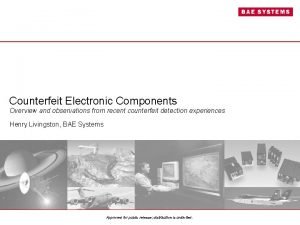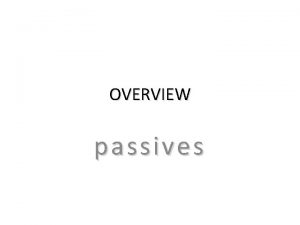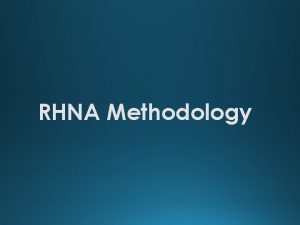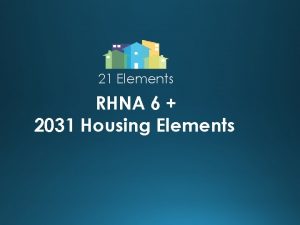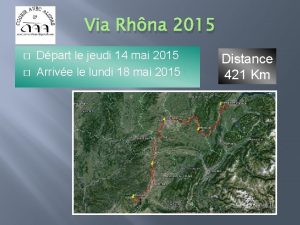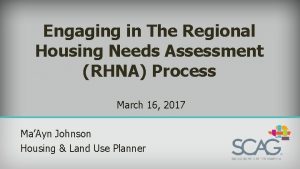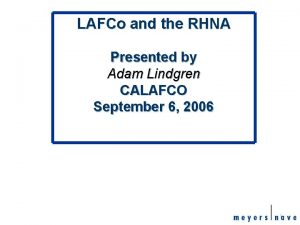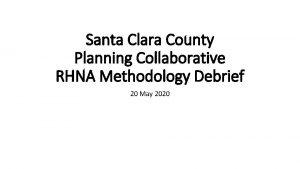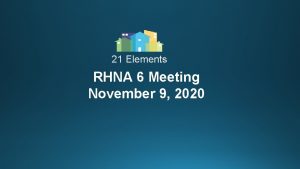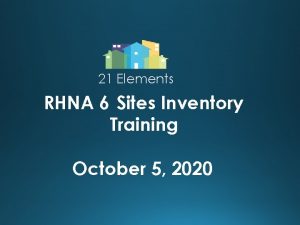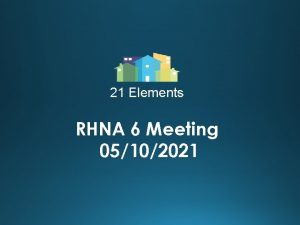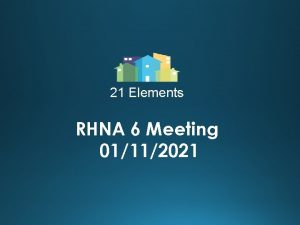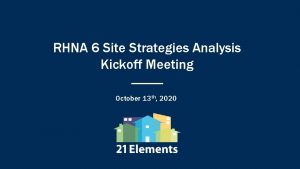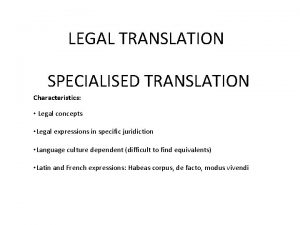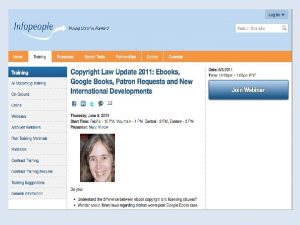RHNA SHARING 2 LEGAL OVERVIEW RHNA SHARING WORKSHOP






























- Slides: 30

RHNA SHARING

2 LEGAL OVERVIEW RHNA SHARING WORKSHOP SILICON VALLEY COMMUNITY FOUNDATION MEETING WEDNESDAY, FEBRUARY 15, 2017 GOLDFARB & LIPMAN LLP 1300 CLAY STREET, 11 TH FLOOR OAKLAND, CALIFORNIA 94612 (510) 836 -6336 BARBARA KAUTZ goldfarb lipman attorneys BKAUTZ@GOLDFARBLIPMAN. COM

3 RHNA SHARING IN CURRENT LAW COUNTY TO CITIES I (G. C. 65584. 07(a)) Between adoption of RHNA by ABAG and due date of housing element Only from county to cities in county Must transfer lower, moderate, and above moderate RHNA in same proportion (e. g. , 5% reduction in each income level) “Shall” be approved if meet conditions

4 RHNA SHARING IN CURRENT LAW COUNTY TO CITIES II (G. C. 65584. 07(d)) Upon annexation If a DA, transfer must be based on DA; units cannot have already been assigned to city Mutually acceptable agreement must be accepted by ABAG and HCD City must amend housing element within 180 days

5 RHNA SHARING IN CURRENT LAW COUNTY TO CITIES III - NAPA COUNTY PROVISION (G. C. 65584. 6) (EXPIRED 6 -30 -07) 15% of current lower income share for $$ but no more than 40% of lower income units actually built in the county City receives no credit; must have certified housing element; must have sites for additional units; must build 20% of very low income RHNA Detailed HCD review

6 RHNA SHARING IN CURRENT LAW SUBREGIONAL ENTITIES (G. C. 65584. 03) Can effectively transfer RHNA among cities and the county

OTHER RHNA ALTERNATIVES 7 PRESERVATION AND CONVERSION (G. C. 65583. 1(c) Up to 25% of lower income RHNA Must ID in housing element; enter into agreement between beginning of ‘projection period’ and 2 years after due date (1 -14 to 1 -17) City must have constructed at least some lower income housing in previous housing element period

FAIR HOUSING ISSUES 8 DISPARATE IMPACT (Fair Housing Act & FEHA) Any action that increases, reinforces, or perpetuates segregated housing patterns May be justified if necessary to achieve other legitimate goals; which could not be served by practice with less discriminatory effect

FAIR HOUSING ISSUES 9 “AFFIRMATIVELY FURTHERING FAIR HOUSING” Must take affirmative steps if receiving federal funds (CDBG and HOME) Applicable to most communities over 50, 000 population and “urban counties” Goals are to: overcome patterns of segregation; foster inclusive communities; increase housing choice

10 LIMITS ON FUND EXPENDITURES IMPACT FEES BASED ON NEXUS STUDIES (COMMERCIAL AND RENTAL) Must be used to mitigate impacts of the development (employees who need affordable housing) Joint nexus studies looked at countywide impacts Existing examples of regional impact fees

11 LIMITS ON FUND EXPENDITURES IN LIEU FEES AND FEES FROM DEVELOPMENT AGREEMENTS Would depend on provisions in local ordinances and each development agreement In general, could be more difficult to spend outside the city

12 LIMITS ON FUND EXPENDITURES HOUSING SUCCESSOR PROGRAM INCOME (H & S 34176. 1(c)(2); SB 341) May be shared only among housing successors; max $1 M per year Only for rental transit priority projects, supportive, farmworkers & special needs projects serving 60% median & below Certified housing elements; not in area 50% very low income unless near transit

13 LIMITS ON FUND EXPENDITURES ‘BOOMERANG’ FUNDS (H & S 34191. 30; AB 2031) Allows communities to bond their ‘boomerang’ funds But – must be spent within the jurisdiction

SOME OBSERVATIONS 14 Advocates very resistant to allowing cities to buy out of lower income obligations If bills pass, have provisions making them unworkable Usually trading must be done before element adoption Transferring city must have built affordable housing

SOME OBSERVATIONS 15 Can’t increase segregation or concentrate poverty Nexus fees may be easiest to transfer

16 LEGAL OVERVIEW RHNA SHARING WORKSHOP SILICON VALLEY COMMUNITY FOUNDATION MEETING WEDNESDAY, FEBRUARY 15, 2017 GOLDFARB & LIPMAN LLP 1300 CLAY STREET, 11 TH FLOOR OAKLAND, CALIFORNIA 94612 (510) 836 -6336 BARBARA KAUTZ goldfarb lipman attorneys BKAUTZ@GOLDFARBLIPMAN. COM

2004 Napa County RHNA Transfer (1999 -2006 Housing Element Planning Period) PROBLEM: Napa County could not obtain certification of its Housing Element (2003) § Insufficient housing sites § Constrained by voter initiatives § County needed to transfer 1, 058 units UNIQUE TO NAPA: At that time, 15% of Napa County’s RHNA allocation for very low and low income housing could be met in the cities (since expired)

Steps in the Napa County RHNA Transfer Process 1 Local review and signed 2 ABAG and HCD approval and agreements (MOUs) certification of three updated housing elements by HCD

Technical Analysis Identify housing sites and future capacity Establish affordability levels for sites Support ABAG RHNA factors Ensure a proportional transfer of the County’s RHNA cities for very low and low income units (43%) and moderate and above moderate income units (57%) to the

Low and very low income RHNA must be reduced proportionally to moderate and above moderate income RHNA

664 Units 394 Units Excess long-and short-term capacity for both multi-family and single family housing in Napa and American Canyon were critical to the success of the negotiations

Summary — Two Track Local Process Local Track A: TECHNICAL/LEGAL ANALYSIS by Staff § Make the RHNA numbers work for all § Achieve HCD/ABAG approval Local Track B: NEGOTIATIONS by Decision-Makers § Reach agreement to accept the County’s remaining RHNA § Reach agreement on the value of the RHNA transfer End Results (1) Local transfer agreement finalized (2) Updated Housing Elements prepared and adopted (3) Updated Housing Elements certified by HCD

Basics of the Local Transfer Agreement Napa County Both Cities Received • 1, 058 units transferred • 456 very low/low • 602 units moderate and above moderate City of Napa (664 Units) City of American Canyon (394 Units)

The Death and Life of Great California Bills

• • Allows payments for transfer of RHNA Must be consistent with regional growth plan Same region (e. g. ABAG) Public hearing

• City of Lakewood • Marin County

Original • Allows payments for transfer of RHNA • Must be consistent with regional growth plan • Same region • Must transfer all income levels • Public hearing • Cities must be close to each other (same county or same commute/10 miles) • Must transfer all income levels • Will not cause racial, ethnic, or economic segregation. • One transfer per city per cycle • No more than 30% of RHNA • Sunset clause (2018)

• City of Lakewood • Marin County


 Pcs7 overview
Pcs7 overview Ospf overview
Ospf overview Dual mode in os
Dual mode in os Nature of hrm
Nature of hrm Overview of plants
Overview of plants General overview
General overview Sa/sd vs jsd
Sa/sd vs jsd Classification of matter
Classification of matter Mpls header format
Mpls header format Informatica repository navigator dock
Informatica repository navigator dock An overview of data warehousing and olap technology
An overview of data warehousing and olap technology Azure platform overview
Azure platform overview Introduction to gym management system
Introduction to gym management system What is project overview example
What is project overview example 3 lobes of lung
3 lobes of lung Infrastructure of m commerce
Infrastructure of m commerce Uml overview
Uml overview Dna purification overview
Dna purification overview Chapter 1 overview of financial statement analysis
Chapter 1 overview of financial statement analysis Hyper-v overview
Hyper-v overview Emt chapter 14 medical overview
Emt chapter 14 medical overview Telecom industry overview
Telecom industry overview Chapter 9 lesson 2 photosynthesis an overview
Chapter 9 lesson 2 photosynthesis an overview Sbic program
Sbic program Agenda zara
Agenda zara Pervasive integration
Pervasive integration Counterfeit electronic components an overview
Counterfeit electronic components an overview Tooth numbering system in usa
Tooth numbering system in usa Ergative verbs
Ergative verbs App service overview
App service overview How to write an informal email
How to write an informal email


